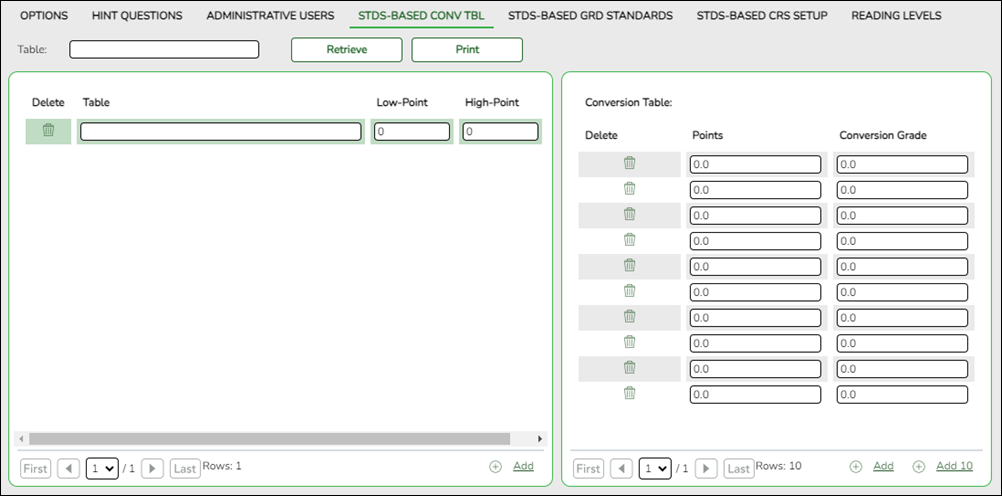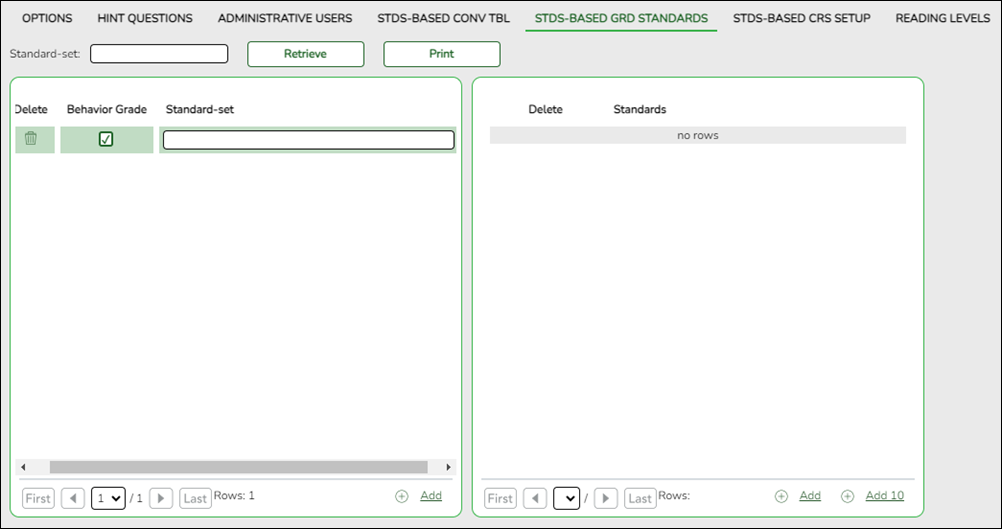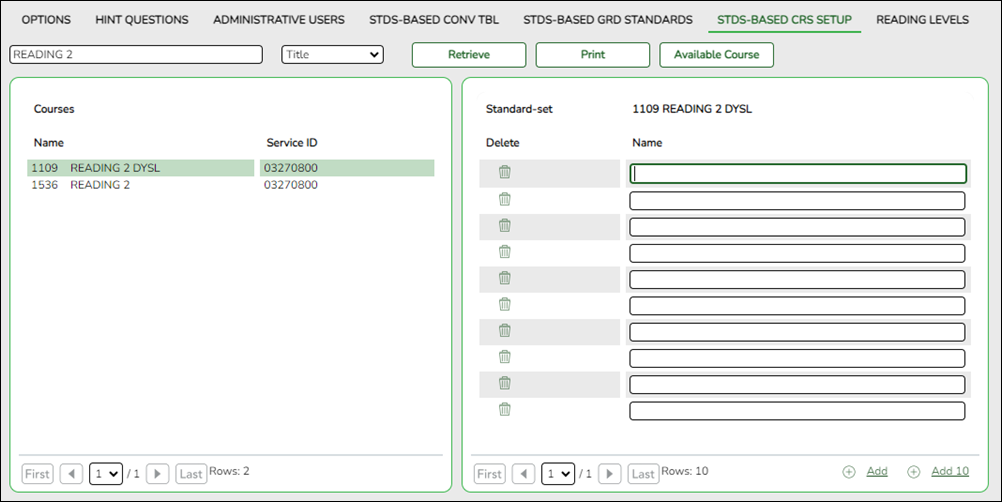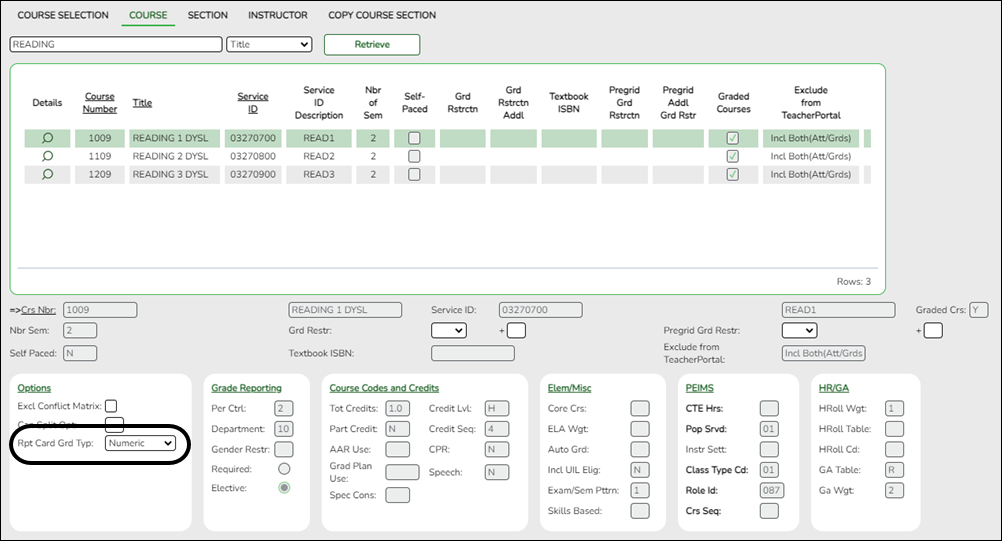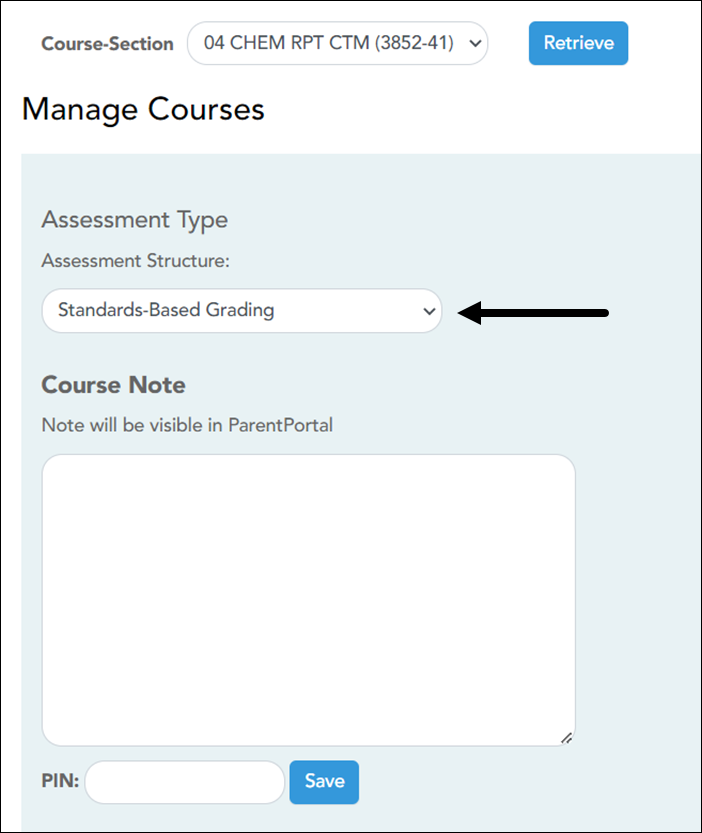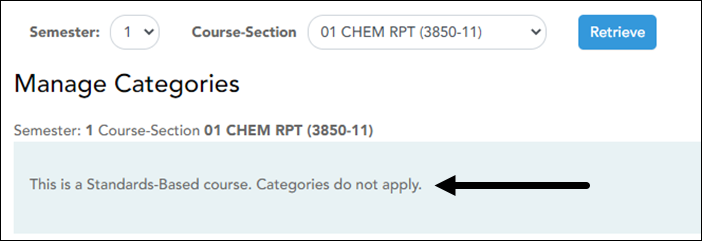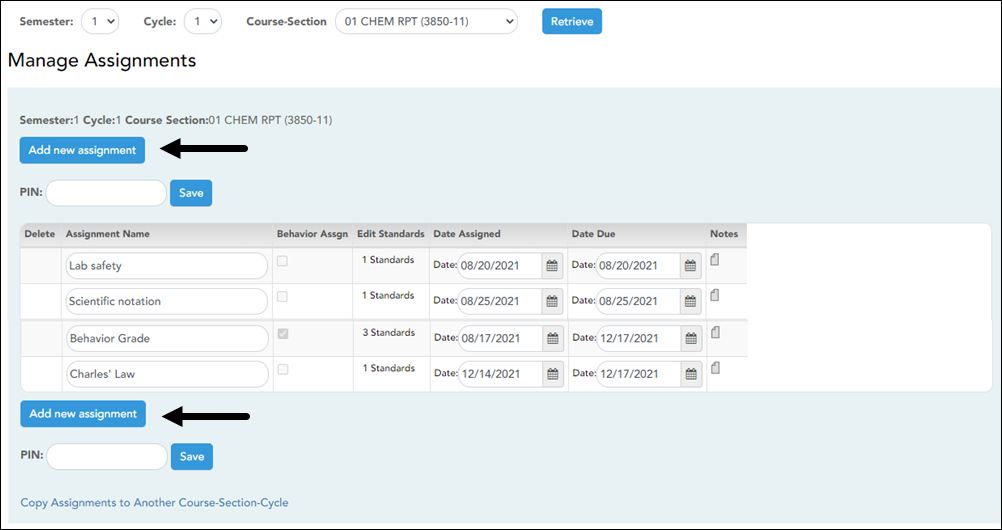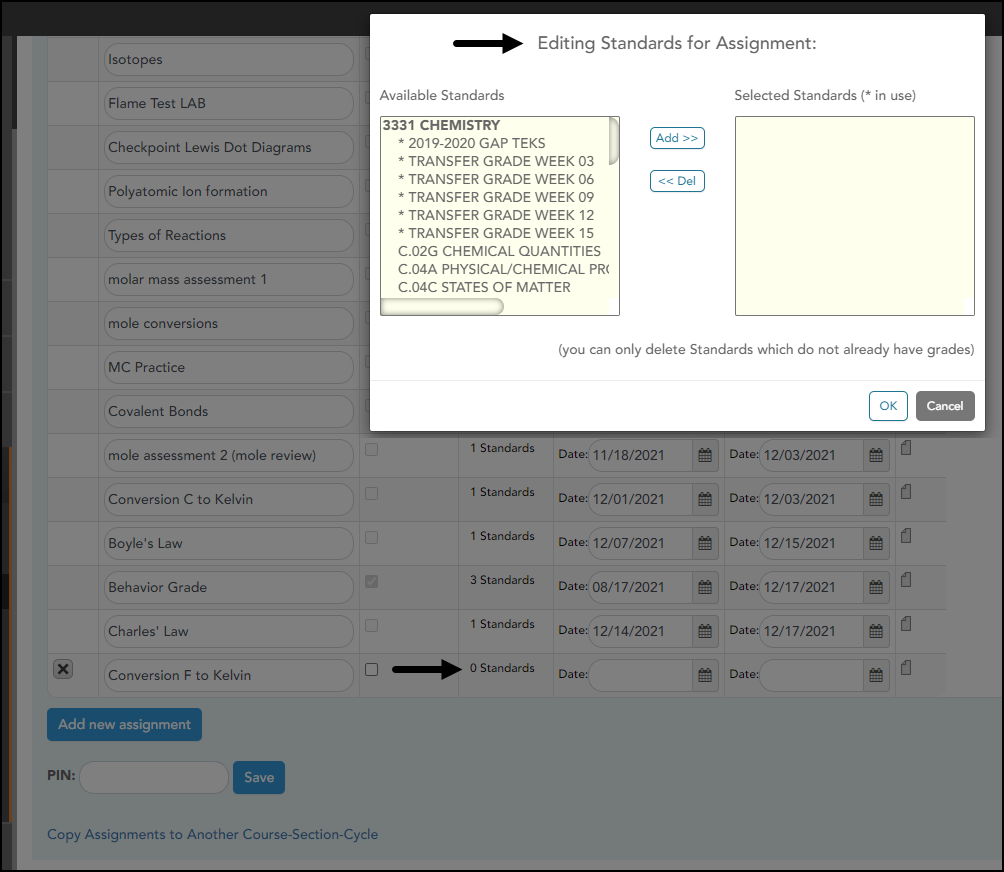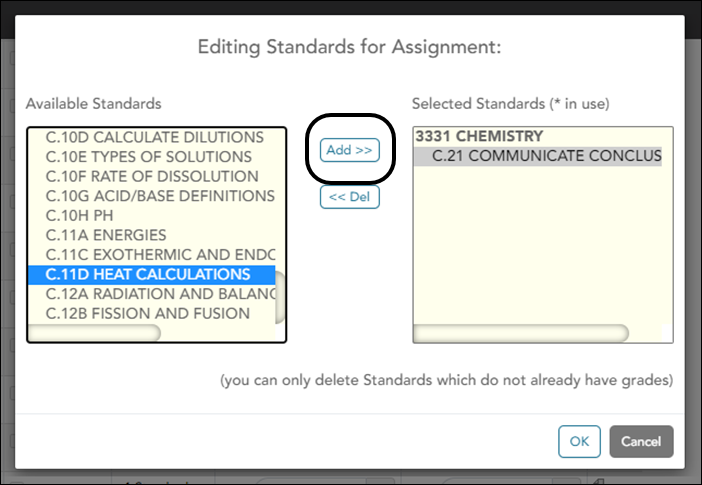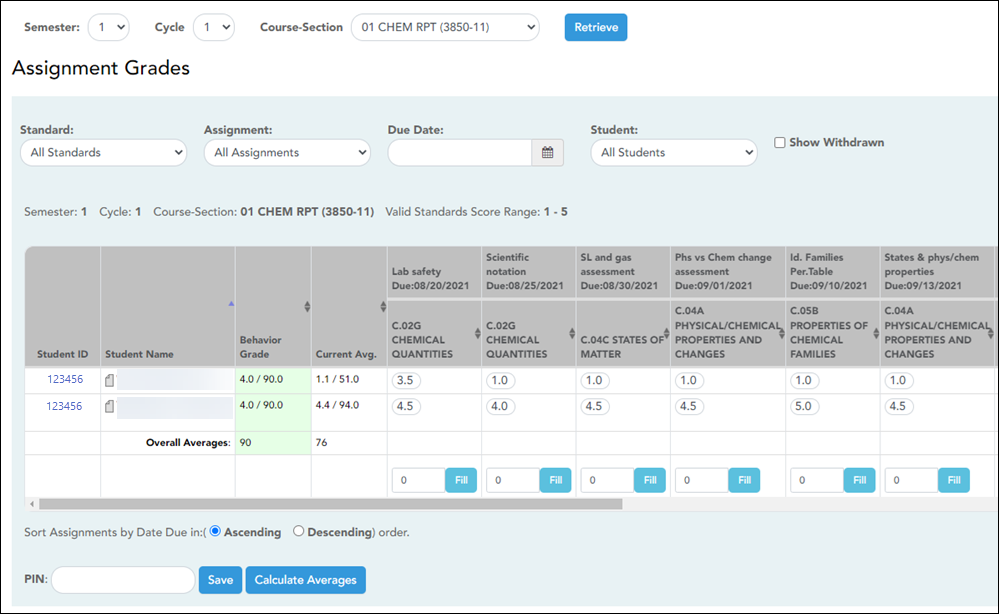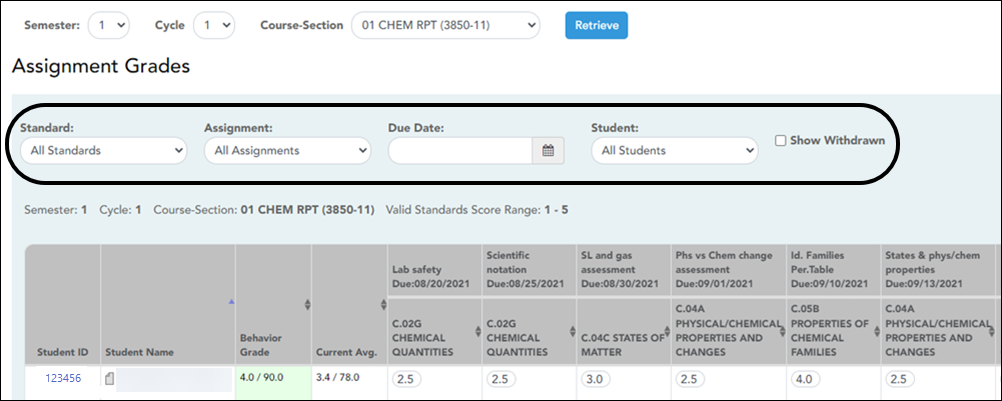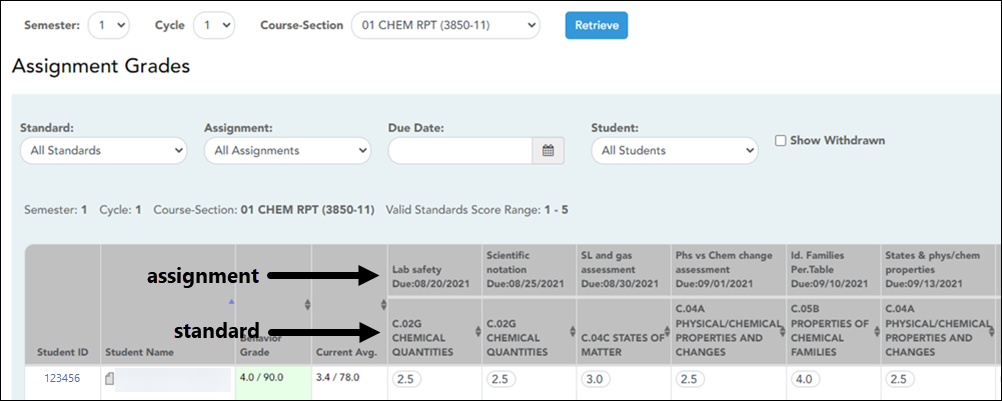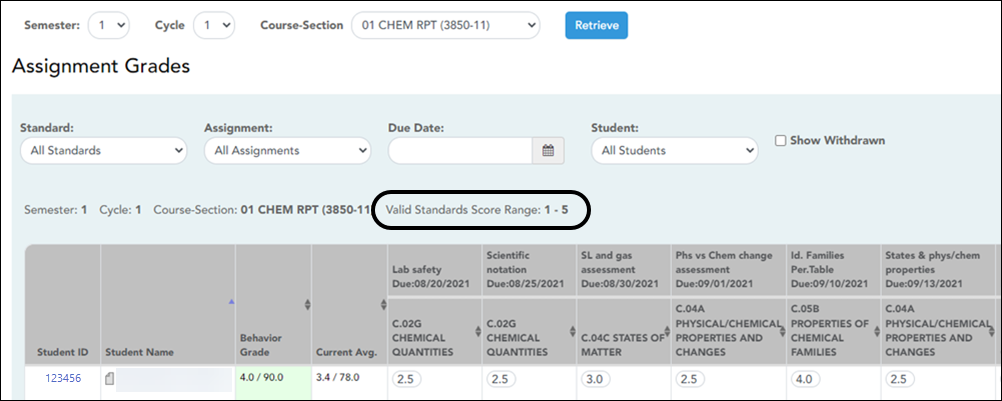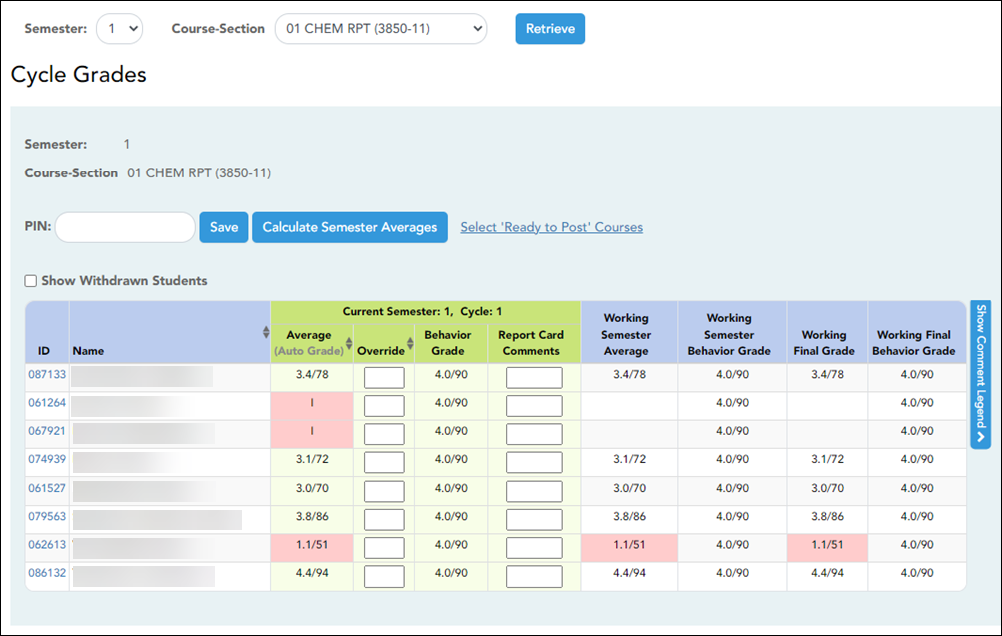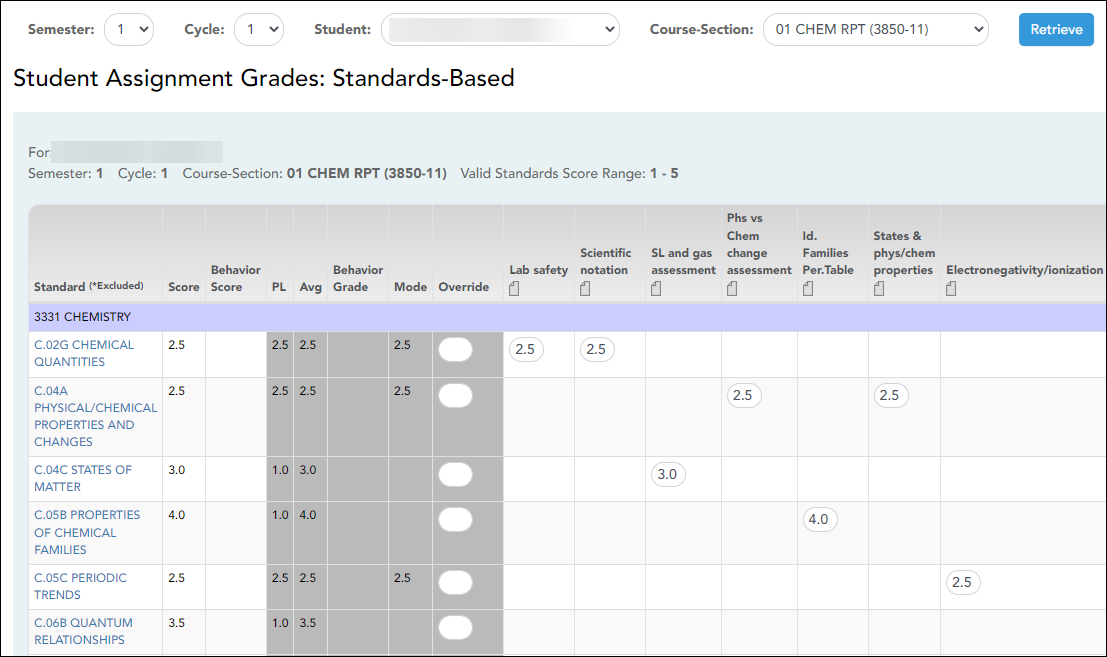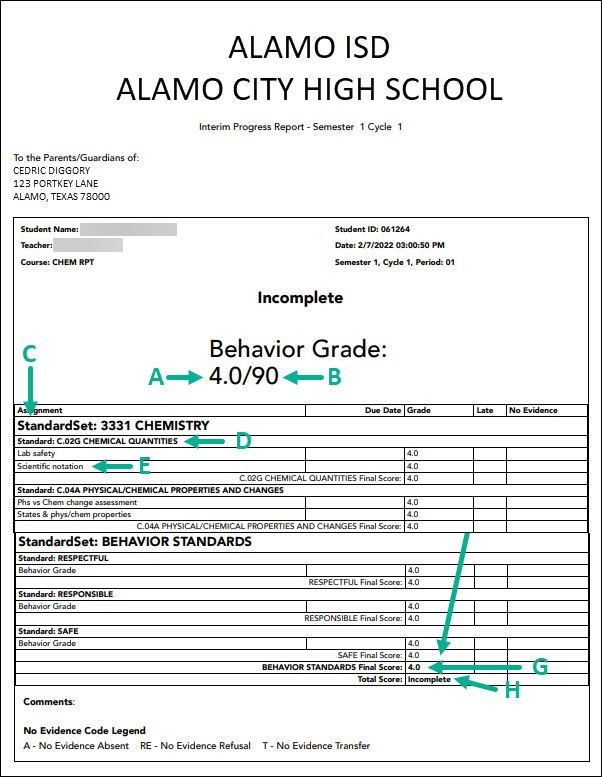User Tools
Sidebar
Add this page to your book
Remove this page from your book
ASCENDER Standards-Based Grading, Set-Up and Use
Standards-Based Grading is a system of reporting student proficiency as specific learning goals (i.e., standards). If a course uses standards-based grading, assignments are associated with one or more standards. The standards are grouped together into standard sets. An assignment may be associated with more than one standard, and may be associated with multiple standard sets.
With standards-based grading, a student’s score may reflect the average for the standard, which is calculated by adding all scores for all assignments associated with the standard, and dividing by the number of assignments. Or, the student’s score may be calculated using the Power Law computation. The higher of the two is displayed as the student’s standard score unless the instructor has entered an override score. If an override score is entered, it is always displayed as the student’s average.
The Power Law Computation is based on the idea that a student’s later scores should have more weight than his earliest scores, because later scores are more reflective of the student’s accumulated knowledge. See the Power Law Computation chapter at the end of this guide for more information.
This guide covers the steps used by instructors to set up and use Standards-Based Grading.
Prerequisites
❏ This guide assumes you are familiar with the basic features of ASCENDER Grade Reporting and TeacherPortal and have reviewed the TeacherPortal guide.
❏ You must have ASCENDER Grade Reporting access to:
- District-wide conversion tables and standard sets for standards-based
- grading.
- District-wide course setup for standards based grading.
- District Master Schedule course maintenance.
- Campus Master Schedule course maintenance.
❏ You must be a registered TeacherPortal user and be logged on to a campus that allows standards-based grading.
❏ Standards-based grading must already be set up at the administrative level before an instructor can set up courses.
Checklist Overview
The following steps are covered in this guide:
❏ Set up the course.
- Designate a course as standards-based.
- Select the standards for each course.
❏ Enter scores throughout the cycle.
❏ View a student's scores as needed.
❏ Print IPRs as needed.
Set Up Standards-Based Grading in Grade Reporting
Setup Standards-Based Conversion Tables
Setup District-wide Standard Sets and Their Standards
Setup District-Wide Standard Sets and Their Standards
This page allows the user to create and maintain district-wide standard sets (comprised of individual standards) to be used for the Standards-Based Grading concept in TeacherPortal.
Grade Reporting > Maintenance > TeacherPortal Options > District > Stds-Based Grd Standards
Assign Standard Sets to Courses
Assign Standard Sets to Courses
This page allows the user to assign standard sets to courses for use in the Standards-Based Grading concept in TeacherPortal.
Grade Reporting > Maintenance > TeacherPortal Options > District > Stds-Based Crs Setup
❏ Select Course Number or Title then begin typing in the search drop-down box. A list of options is provided.
❏ Or, click on the Available Courses button to retrieve the course from the District Master Schedule.
Click on the course’s spyglass, then click the Stds-Based Crs Setup button to return to the Stds-Based Crs Setup tab. The course will display in the Courses box.
❏ Click Retrieve.
Select the Report Card Type for the Course
Set TeacherPortal Campus Options
Set TeacherPortal Campus Options
This page allows the user XXXXX.
Grade Reporting > Maintenance > TeacherPortal Options > Campus > Options
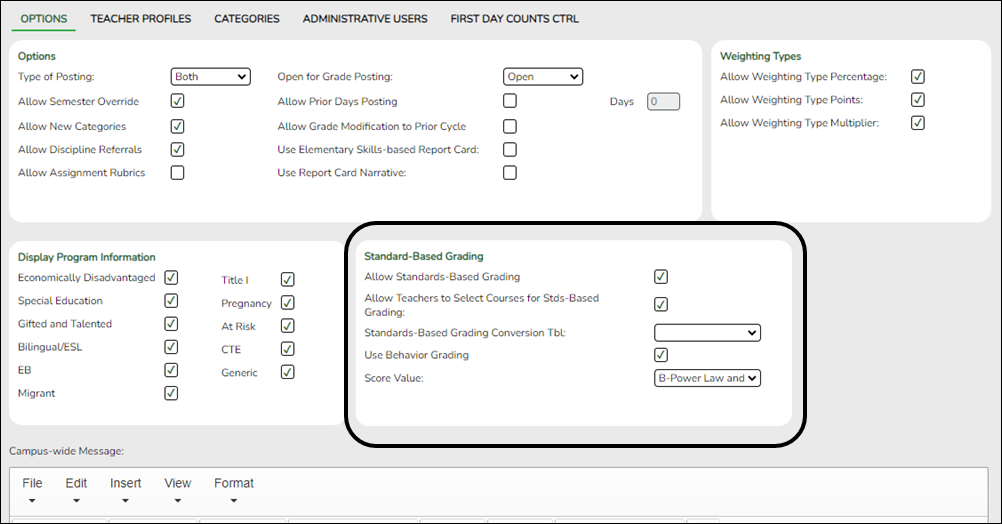
Under Standards-Based Grading:
❏ Select Allow Standards-Based Grading.
❏ Select Allow Teachers to Select the Courses for Stds-Based Grading.
❏ Select a Standards-Based Grading Conversion Table to use on the campus.
❏ Select Use Behavior Grading.
❏ Select a Score Value to use on the campus.
❏ Click Save.
Set Up a Standards-Based Course
Designate a Course as Standards-Based
Designate a Course as Standards-Based
The Manage Courses page allows you to set course-wide information, such as whether a course uses category-based (i.e., regular) or standards-based grading. Data entered on this page affects only the selected course section. You must specify a course as standards-based before continuing.
Settings > Manage Courses
❏ In the Course Section field, select the course section for which you want to add data. You must select a course that has been set up to allow standards-based grading, as described in the TeacherPortal Administrator - Set Up Standards-Based Grading “How To” guide.
❏ In the Assessment Type field, select Standards-Based Grading.
- The field is only displayed if both the campus and the course are set up to use standards-based grading. It is not displayed if the campus has disabled the teacher’s ability to determine the assessment type for the course.
- You must continue to use the same assessment type for the remainder of the year. You cannot use standards-based for only one semester.
❏ Click Save
Set Up Assignments
NOTE: Categories are not used for standards-based courses, so it is not necessary to set up categories on Settings > Manage Categories before entering assignments.
The Manage Assignments page allows you to enter assignments for your active courses, including standards-based courses. Different fields are displayed according to the type of course selected.
Settings > Manage Assignments
❏ Select the semester, cycle, and course section, and click Retrieve Data.
Any assignments that have previously been entered for the semester-cycle-course section are displayed. Otherwise, the message “No Assignment Exists” is displayed.
❏ Click Add new assignment. A blank row is displayed.
❏ In the Assignment Name field, type a name for the assignment. The field can be up to 50 characters and is required.
❏ The Behavior Assign checkbox indicates an assignment that will be using a behavior standard.
❏ In the Edit Standards field, the number of standards currently associated for the assignment is displayed. A new assignment will have 0 standards.
The Edit Standards field is only displayed for standards-based courses; the Category field is displayed for category-based (i.e., regular) courses.
To add standards, click the # Standards link.
The Editing Standards for Assignment: Assignment Name dialog box is displayed.
Under Available Standards (left), all available standard sets and associated standards are displayed.
❏ Under Available Standards, click the standard to associate with the assignment.
Click Add ». The selected standard is moved to the Selected Standards (right) list under the appropriate standard set name.
❏ To remove a standard for an assignment, select the standard under Selected Standards, and then click « Del. The standard is moved back to the Available Standards list and is no longer associated with the assignment.
❏ Click OK to close the dialog box and retain the changes.
The Edit Standards field is updated to reflect the number of standards associated with the assignment.
❏ In the Date Assigned field, enter the date the assignment was assigned.
❏ In the Date Due field, enter the date the assignment is due.
❏ In the Notes field, click the ![]() to add optional notes for the assignment. If entered, these notes are displayed in ParentPortal.
to add optional notes for the assignment. If entered, these notes are displayed in ParentPortal.
❏ Click Add new assignment to add another assignment. Continue adding assignments as needed.
❏ To delete an assignment, Click ![]() under Delete.
under Delete.
❏ Type the four-digit PIN and click Save. An assignment cannot be saved unless it has at least one standard associated with it.
Enter Grades for a Standards-Based Course
Grades for standards-based grading are entered on the Assignment Grades and Cycle Grades pages.
Assignment Grades
The standards-based Assignment Grades page allows you to enter standards-based scores for students by semester, cycle, and course section throughout the cycle. For each assignment, you enter scores for all associated standards, so an assignment will often have multiple scores. The scores are converted into a standard 100%-based (i.e., regular) grade for the course.
Grades > Assignment Grades
The standards-based Assignment Grades page is displayed if you select a course section that is using standards-based grading. The page is automatically displayed instead of the regular Assignment Grades page. If you change between a standards-based course section and a category-based (i.e., regular) course section, the appropriate page loads.
❏ Select the semester, cycle, and course section, and click Retrieve Data.
❏ By default, all assignments for all students are displayed. To view a specific set of information, make one or more of the following selections:
❏ In the Standard field, select a standard to view data for only one standard. Or, select All Standards to view all standards associated with each assignment.
If you filter by a standard, the following applies:
• If an assignment has multiple associated standards, only the selected standard is displayed under the assignment heading.
• If an assignment is not associated with the selected standard, the assignment is not displayed in the grid.
❏ In the Assignment field, select the assignment for which you want to enter scores. You can select one assignment or all assignments.
❏ In the Due Date field, enter a date if you want to view only assignments that are due on or after that date.
❏ In the Student field, select the student for whom you want to enter scores. You can select one student or all students.
The students and assignments are displayed according to your selections.
For each assignment, the associated standards are displayed as set up on Settings > Administer Assignments. Scores are entered for each standard, so an assignment may have multiple scores.
❏ Enter the scores in the fields provided.
❏ The Valid Standards Score Range field above the grid displays the range of valid scores for the course. Scores must be entered according to this range.
❏ When scores are entered or changed, the table cell turns grey to indicate that the score was changed but not yet saved. Once the scores are saved the cell is no longer grey.
❏ Only numeric scores can be entered. However, the following codes can be entered in place of a score:
• I - Incomplete
❏ The following codes can be entered as properties of the score entered:
• L - Late
• R - Re-do
HINT: Type and save the code first. Then add the score.
If you type one or more of these codes for a score, an icon is displayed when you click Save to indicate the properties associated with the score. The icon displays the code (I, L, or R).
NOTE: The code will be applied to all standards for the assignment, even though it is entered for one standard.
Code I can be updated with a numeric score as needed. However, you cannot remove codes L and R from the score field. Instead, you must open the Grade Properties dialog box from the Student Assignment Grades: Standards- Based page, update the properties, and save the changes.
❏ Scores can be mass entered, mass excluded, mass replaced, or mass deleted. For more information, view the online Help for this page.
❏ For more information about navigating the page, view the online Help for this page.
❏ The Behavior Grade field displays the overall behavior score for the course section followed by the conversion grade (e.g., 4.5/90, where 4.5 is the student’s total score, and 90 is the student’s converted grade). The converted grade is based on the table entered in Grade Reporting on Maintenance > TeacherPortal Options > District > Stds-Based Conv Tbl. If the student does not yet have a working cycle behavior average, the field is blank.
❏ The Current Avg. field displays the overall score for the course section followed by the conversion grade (e.g., 4.5/90, where 4.5 is the student’s total score, and 90 is the student’s converted grade). The converted grade is based on the table entered in Grade Reporting on Maintenance > TeacherPortal Options > District > Stds-Based Conv Tbl. If the student does not yet have a working cycle average, the field is blank.
The average is updated every time you access the page, click Calculate Averages, or save scores.
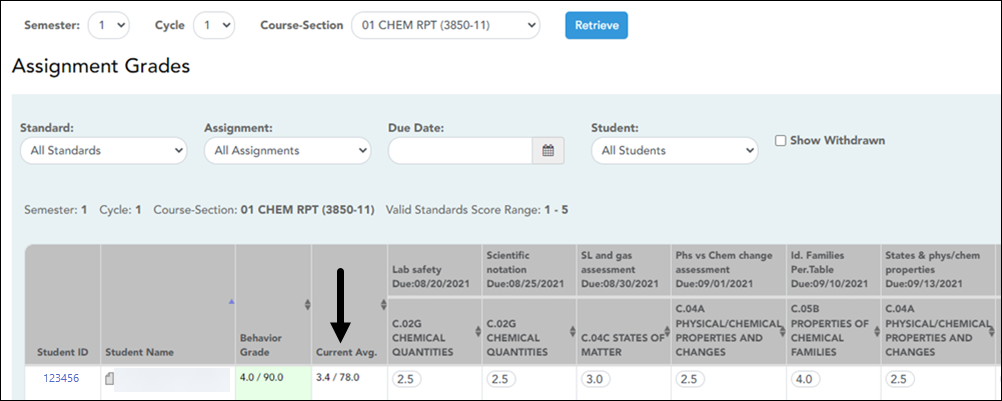
The score displayed is the highest score between the score average and the power law average. If an override score exists, the override score is always displayed instead.
❏ The Overall Averages (i.e., class average) number is displayed in the bottom of the grid. The overall average is updated every time you click Calculate Averages or Save Grades.
❏ You can click ![]() to add a course note about the student. The Student Course Note dialog box opens allowing you to enter or update comments. For more information about adding student-specific course notes, view the online Help for this page.
to add a course note about the student. The Student Course Note dialog box opens allowing you to enter or update comments. For more information about adding student-specific course notes, view the online Help for this page.
❏ Type the four-digit PIN and click Save Grades.
WARNING: Be aware that you may have changed data that is not currently displayed on the page. All changes are saved, including those that are not visible on the page. For example, if you are currently viewing scores for one student, but you previously entered scores for other students, the scores for all students are saved, regardless of what is displayed on the page at the time you save the data.
❏ Click the Student Name link to view the student's detailed score information. The Student Assignment Grades: Standards-Based page opens. See the “View a Student's Scores” section for a detailed explanation.
Cycle Grades
Cycle Grades for a standards-based course are entered the same as for a category-based (i.e., regular) course. For more information, view the online Help topic for the Cycle Grade page.
Grades > Cycle Grades
❏ The Average column displays the current average, which is the same as the Current Avg field on Grades > Assignment Grades. Only the converted grade is displayed.
❏ The final scores and calculated average are cumulative for the semester. The final score displayed is the highest score of the following:
• The student’s current average for the standard, which is calculated by adding all scores for all assignments associated with the standard, and dividing by the number of assignments.
• The student’s score as calculated using the power law computation.
• If an override grade is entered, the override grade is always displayed.
❏ The final standard score reflects standard scores for all cycles in the semester, even though only one cycle is displayed at a time.
❏ The average does not include scores of zero, unless zero is a valid grade for the campus.
View a Student's Scores
The Student Assignment Grades: Standards-Based page allows you to view and enter a student’s scores in a particular course section for a semester-cycle.
Grades > Student Assignment Grades
You can access the page from the Grades > Assignment Grades (standards-based) page. Retrieve a standards-based course, and then click a student’s name. The Student Assignment Grades: Standards-Based page is displayed allowing you to view and enter a student’s data.
❏ The following data is displayed:
❏ The student's data for the semester-cycle is displayed; however, standards and standard sets are listed if they were part of any of the student's assignment during the semester.
For example, a standard that was only assigned to an assignment is cycle 1 is displayed in the list for later cycles; however, the assignments and their related scores for previous cycles are not displayed.
❏ Each assignment for the semester-cycle is displayed in a column. If a standard is assigned to the assignment during the cycle, an input field is displayed. Existing scores are displayed; otherwise, the field is blank. You can add or update the score fields.
The score must be within the range of the rubric grid, as defined by the district. You can enter whole numbers or a number with one decimal place (e.g., 3.5).
If you click a standard, the Standard Score Trend dialog box opens. This displays line chart depicting the student’s progress for the standard. The vertical line represents the rubric scores as established by the district, and the horizontal line represents the assignments that are associated with the selected standard. The data is display only.
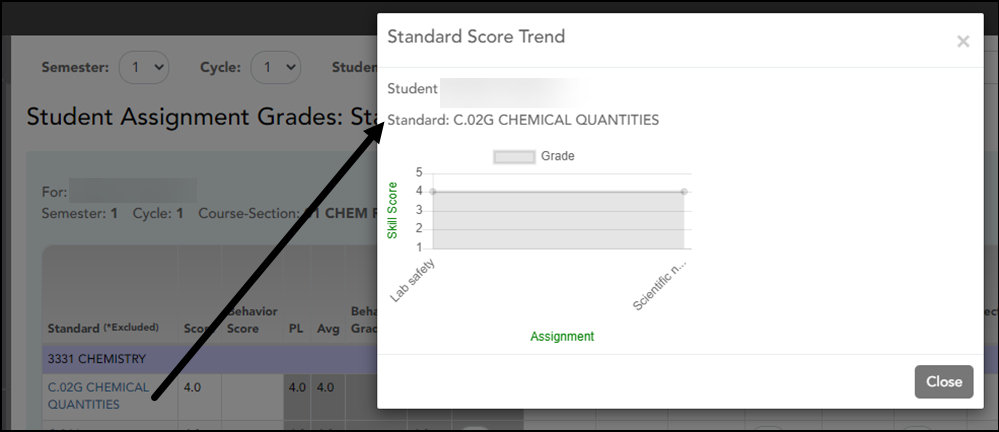
Click Close to close the dialog box.
❏ The Score column displays the student's overall score for the assignment for all cycles in the semester. The score is either the higher score or the average (Avg column) and the power law average (PL column) or the override score it it exists. The override score is always displayed if it exists in any cycle in the semester.
❏ The PL (power law) column displays the student's average for the assignment based on the power law formula, which is described later in this guide.
❏ The Avg column displays the student's current average for the standard, which is calculated by adding scores for all assignments associated with the standard and dividing by the number of assignments.
NOTE:
The average displayed will reflect scores from all assignments associated with the standard, including previous cycles in the semester. For example, if it is currently cycle 3 of the semester and the standard was associated with assignments in cycles 2 and 3, the average will reflect scores for the entire semester, even though only cycle 3 is displayed.
❏ The Mode column displays the mode if one exists. The mode is the standard score that appears most often for the semester to date. It is cumulative for the semester, not just the current cycle. There can be more than one mode.
NOTE:
• If all scores occur the same number of times, there is no mode, and the column is blank.
• If two or more scores are tied for most number of occurences, (i.e., bi-modal or multi-modal), all will be displayed.
Examples:
• If the student’s standard scores for the semester are 1, 2, 4, 2, the mode is 2.
• If the student’s standard scores for the semester are 1, 1, 3, 2, 4, 2, the mode is
1,2.
• If the student’s standard scores for the semester are 1, 2, 3, 4, there is no mode.
❏ In the Override field, you can type an override score for the standard. If an ovverride score is entered, it overrides the scores in the PL and Avg columns and it will always be displayed in the Score field.
• The override score must be within the range of the rubric grid, as defined by the district. You can enter whole numbers or a number with one decimal place (e.g., 3.5).
• If an override score was entered in a previous cycle in the semester, the score is carried over to the later cycles in the semester. However, if you enter an override score after cycle 1, it only applies to the current and later cycles for the semester.
NOTE:
If you want to dismiss an override grade for the entire semester, it must be cleared in all cycles of the semester.
❏ For each standard set, the Standard Set Score row displays the average of all overall standard scores for each standard set.
• The average does not include scores of 0, unless a 0 exists in the rubric grid. It is rounded to one decimal place.
• This average is cumulative for all cycles in the semester.
❏ The Total Score row at the bottom of the table displays the average of all Standard Set Scores.
❏ The Conversion Grade row at the bottom of the table displays the standard 100%-based grade, which is a conversion from the Total Score. The conversion scale is determined by the district in the Student system.
❏ The averages are updated every time you access the page, click Calculate Grades, or save the scores.
❏ Comments and indicators can be entered for each assignment grade. For more information, view the online Help for this page.
❏ Type a four-digit PIN and click Save.
❏ To retrieve data for another semester-cycle or student, change theSemester, Cycle, Student, or Course Section fields.
❏ To return to the standards-based Assignment Grades page, click Back to the Assignment Grades.
Print IPRs
Interim progress reports (IPRs) display different data for courses using standards-based grading. For general information about printing IPRs, view the online Help for the page.
Grades > Print IPR
Grades > Print IPR by Average
The semester and cycle are displayed at the top of the IPR. However, the final scores and calculated average are cumulative for the semester.
For standards-based courses, the following is included on a student's IPR:
❏ A - Conversion Grade: This is the grade that appears on Grades > Cycle Gradesin the Average column. It is the student's average to date. The average is cumulative for the semester, even though assignment grades are only displayed for the selected semester-cycle.
❏ B - Behavior Grade: This is the behavior grade that appears on Grades > Cycle Gradesin the Average column. It is the student's average to date. The average is cumulative for the semester, even though assignment grades are only displayed for the selected semester-cycle.
❏ C - Standard Set: This is the set of standards with which the graded standard is associated.
❏ D - Standard: This is the standard.
❏ E - assignment name: This is the assignment with which the standard is associated. The grade for each assignment is displayed in the grade column. The assignment grades are displayed for the selected semester-cycle only.
❏ F - Final Score: A final score is displayed for each standard. The score displayed is the highest score of the following:
• The student’s current average for the standard, which is calculated by adding all scores for all assignments associated with the standard, and dividing by the number of assignments.
• The student’s score as calculated using the power law computation.
• If an override grade is entered, the override grade is always displayed.
❏ G - Final Score (standard set): A final score is displayed for each standard set. This is the average of all final scores for each standard. The final standard set score reflects standard set scores for all cycles in the semester, even though only one cycle is displayed at a time. The average does not include scores of zero, unless zero is a valid grade for the campus. The final standard set score is rounded to one decimal place.
❏ H - Total Score: This is the average of all standard set final scores, which takes into account all cycles in the semester. This grade is converted to a standard 100%-based grade using a conversion chart established by the district (e.g., 3/80, where 3 is the student’s total score, and 80 is the student’s converted grade).
Power Law Computation
In standards-based grading, a student’s standard score may reflect the average for the standard, which is calculated by adding all scores for all assignments associated with the standard, and dividing by the number of assignments. Or, the student’s score may be calculated using the Power Law computation. The higher of the two is always displayed as the student’s standard score, unless the instructor has entered an override score.
The Power Law computation is based on the idea that a student’s later scores should have more weight than his earliest scores, because later scores are more reflective of the student’s accumulated knowledge.
The nonlinear power law equation is y = m* xb, where:
❏ y is the score that is being predicted or computed.
❏ x is the score on which the prediction is based, indicating the number of practices the student has had for the standard. For example, if the student has had three assessments to date, starting with a homework assignment, then a quiz, ad then a test, the x score for the homework assignment would be 1, for the quiz would be 2, and for the test would be 3. Each score must have a corresponding assessment number.
Steps:
❏ Calculate the log of x and the log of y for all possible xvalues and all possible y values.
❏ Use the log values for x and y in the linear equation y = mx + b (i.e., log(y) = m* log(x) + b).
❏ Solve for m in this linear equation to get the value for b for the nonlinear equation.

❏ Solve for b in this linear equation to get log(m). Calculate m using the formula m=elog(m) to get the value for m in the nonlinear equation.

❏ Use the new values for m and b in the nonlinear Power Law equation.
Americans with Disabilities Act (ADA) and Web Accessibility
The Texas Computer Cooperative (TCC) is committed to making its websites accessible to all users. It is TCC policy to ensure that new and updated content complies with Web Content Accessibility Guidelines (WCAG) 2.0 Level AA. We welcome comments and suggestions to improve the accessibility of our websites. If the format of any material on our website interferes with your ability to access the information, use this form to leave a comment about the accessibility of our website.


